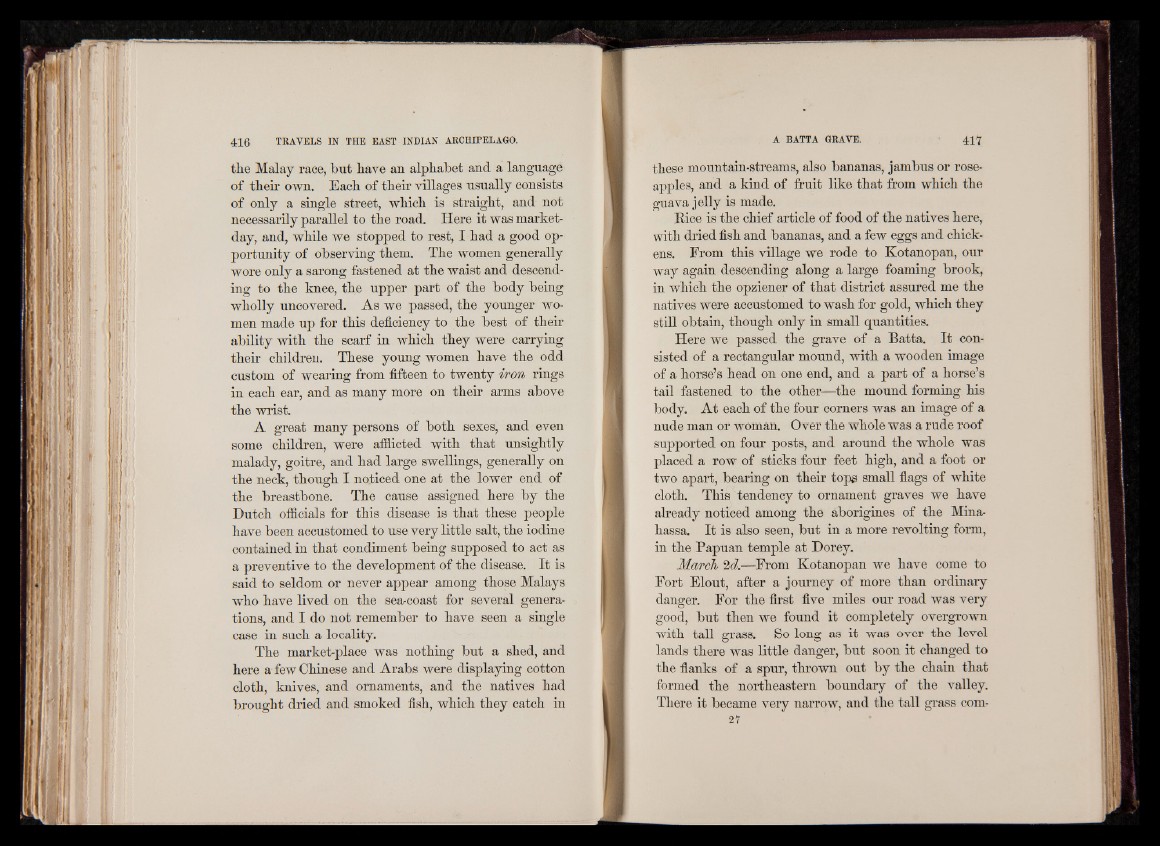
the Malay race, but have an alphabet and a language
of their own. Each of their villages usually consists
of only a single street, which is straight, and not
necessarily parallel to the road. Here it was market-
day, and, while we stopped to rest, I had a good opportunity
of observing them. The women generally
wore only a sarong fastened at the waist and descending
to the knee, the upper part of the body being
wholly uncovered. As we passed, the younger women
made up for this deficiency to the best of their
ability with the scarf in which they were carrying
their children. These young women have the odd
custom of wearing from fifteen to twenty iron rings
in each ear, and as many more on their arms above
the wrist.
A great many persons of both sexes, and even
some children, were afflicted with that unsightly
malady, goitre, and had large swellings, generally on
the neck, though I noticed one at the lower end of
the breastbone. The cause assigned here by the
Dutch officials for this disease is that these people
have been accustomed to use very little salt, the iodine
contained in that condiment being supposed to act as
a preventive to the development of the disease. It is
said to seldom or never appear among those Malays
who have lived on the sea-coast for several generations,
and I do not remember to have seen a single
case in such a locality.
The market-place was nothing but a shed, and
here a few Chinese and Arabs were displaying cotton
cloth, knives, and ornaments, and the natives had
brought dried and smoked fish, which they catch in
these mountain-streams, also bananas, j ambus or rose-
apples, and a kind of fruit like that from which the
guava jelly is made.
Rice is the chief article of food of the natives here,
with dried fish and bananas, and a few eggs and chickens.
Prom this village we rode to Kotanopan, our
way again descending along a large foaming brook,
in which the opziener of that district assured me the
natives were accustomed to wash for gold, which they
still obtain, though only in small quantities.
Here we passed the grave of a Batta. It consisted
of a rectangular mound, with a wooden image
of a horse’s head on one end, and a part of a horse’s
tail fastened to the other—the mound forming his
body. At each of the four comers was an image of a
nude man or woman. Over the whole was a rude roof
supported on four posts, and around the whole was
placed a row of sticks four feet high, and a foot or
two apart, bearing on their tops small flags of white
cloth. This tendency to ornament graves we have
already noticed among the aborigines of the Mina-
hassa. It is also seen, but in a more revolting form,
in the Papuan temple at Dorey.
March 2d.—Prom Kotanopan we have come to
Port Elout, after a journey of more than ordinary
danger. For the first five miles our road was very
good, but then we found it completely overgrown
with tall grass. So long as it was over the level
lands there was little danger, but soon it changed to
the flanks of a spur, thrown out by the chain that
formed the northeastern boundary of the valley.
There it became very narrow, and the tall grass com-
21